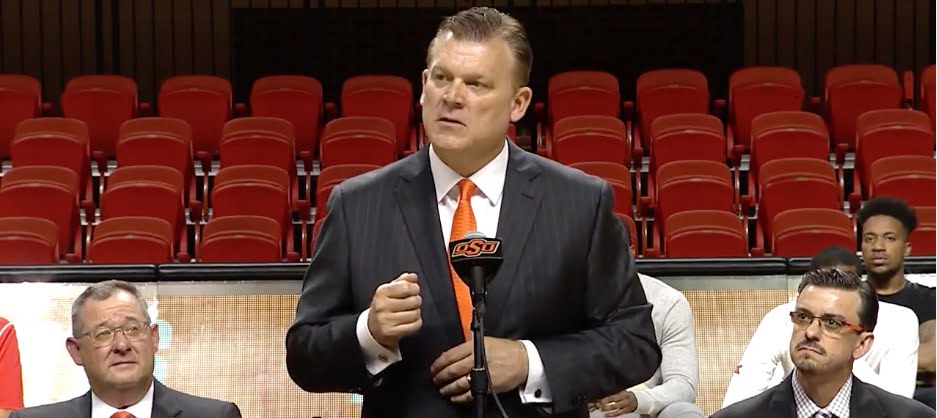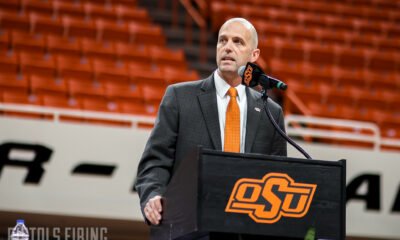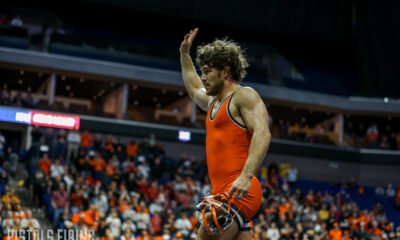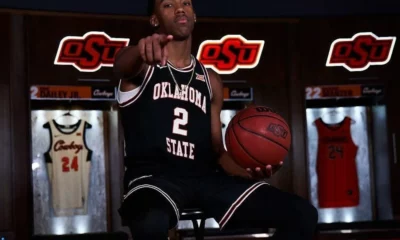Feature
Brad Underwood Represents a Big Change In Philosophy From Travis Ford

It has been incredibly interesting to go back to Travis Ford’s first press conference as the Oklahoma State basketball coach. In retrospect, it seems easy to see why he failed. But the time, it was impossible. He was a (sort of) hotshot young coach with a (sort of) plan to restore OSU basketball to its pre-Sean Sutton days.
“It’s going to be a lot of work, but I like work,” said Ford. “I just met with the team about five minutes ago and I told them, if you don’t like to work, then you’re probably not going to enjoy playing for me because I love the game and I love working hard and I love seeing the reward that you get for working hard and putting in your time.”
Sounds a lot like the new guy this year.
But when you dig a little deeper, you start to notice some stuff that became a harbinger for the Ford era. Crappy, inefficient offenses were built on his offensive philosophy.
“I always thought shooting the basketball was one of the greatest assets you could possibly have as a basketball player,” said Ford. “I think shooting is one of the most important things in a basketball player. You can teach them a lot of things but it’s tough to teach guys to shoot. You can make them a better shooter no question. I think you can make players play defense and how to defend, but if you can get somebody who can really score the basketball and knows how to shoot it, I think that’s an incredible strength and an incredible asset.”
Just “shooting the basketball.” Not threes and layups. Not pace and space. Not a plan other than let Marcus Smart yank long treys and Jeff Newberry pull from 17.5 feet over and over and over again. Now contrast this to what Brad Underwood said recently about his plan on offense.
“I believe in efficient offense,” opened Underwood. “We shot 52 percent this year in conference play. We’ve got guys who can make baskets and they do it in a lot of ways. I believe in the old adage, ‘The closer you are to the basket, the better chance you have to score;’ if you can find ways to make layups and easy opportunities.”

“We slipped a little bit this year in this number, but we’ve always been a great offensive rebounding team with very little size,” said Underwood. “We were 11 or 12 in the country – another opportunity to score the basket. We have a bunch of guys that can go offensive rebound and do those things.
“Offensively we’ll be good. Another thing last year, [Stephen F. Austin] led the country in assists and we were second this year in assists. We had six different guys lead us in scoring and that becomes really hard to prepare for, but the constant has always been at the defensive end.”
Let’s compare Ford’s offensive efficiency (essentially how much you score per 100 possessions) at UMass and then Oklahoma State before we look at Underwood’s at SFA. This is national rank (out of roughly 350 teams).
2005 UMass: No. 215
2006 UMass: No. 93
2007 UMass: No. 65
2009 OSU: No. 16
2010 OSU: No. 31
2011 OSU: No. 114
2012 OSU: No. 90
2013 OSU: No. 68
2014 OSU: No. 27
2015 OSU: No. 55
2016 OSU: No. 165
Additionally, every single one of his teams finished outside the top 170 in the country in offensive rebounding percentage (a feat that would be difficult to accomplish if you tried). Ford’s teams also finished in the top 100 nationally in effective field goal percentage three times in eight seasons.
Here are Underwood’s teams in terms of offensive efficiency.
2014 SFA: No. 38
2015 SFA: No. 32
2016 SFA: No. 50
This is all opponent-adjusted and pace-adjusted of course.[1. If you want to look at non-adjusted, Sam Aldrich had a post here about how SFA has hit the exact same number in offensive efficiency for the last three years.] Top 50 all three years. Ford was trending the right direction at UMass, but never notched a top 50 offensive efficiency team until he got to Stillwater.
If you look a little deeper into Ford’s past, his Eastern Kentucky teams were horrifically inefficient. They contended in a conference similar to the Southland (where SFA plays) and never finished better than No. 167 nationally in offensive efficiency.
Also, Underwood’s teams finished in the top 60 in effective field goal percentage all three years and in the top 20 twice (i.e. they took good shots and made them). They also finished in the top 60 nationally in offensive rebounding percentage all three years (and in the top 15 each of the last two). Underwood noted here that he likes to have 15-20 (!) more field goal attempts than his opponents per game. That’s where that wicked man-to-man D can inform the offense.
After watching these videos, you can understand why all of this works on offense.
Underwood has a plan and executes it. And it’s going to be far different than what we have seen over the past decade in GIA. That’s what I hope anyway.

-

 Football2 days ago
Football2 days agoFour-Star Quarterback Adam Schobel Commits to Oklahoma State, Flips from Baylor
-

 Hoops2 days ago
Hoops2 days ago‘Keep Turning Over the Rocks’: Looking at the Portal Landscape as Lutz Looks to Solidify His First OSU Roster
-

 Wrestling5 days ago
Wrestling5 days agoOSU Wrestling: Olympic Chances End for Cowboy Hopefuls
-

 Hoops2 days ago
Hoops2 days agoFour-Star Signee Jeremiah Johnson Reaffirms Commitment to Oklahoma State after Coaching Change






